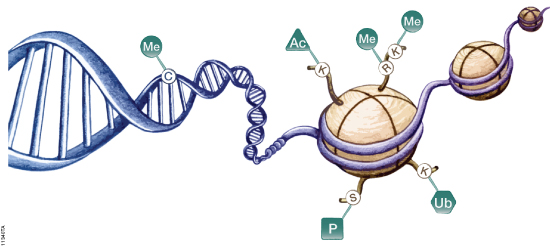 Epigenetics is the study of heritable changes in gene expression arising from chromosomal changes that are not caused by alterations in DNA sequence. It seems that almost daily, this field of study is revealing more and more about the ways in which genes are turned on or off–governing cell fate and regulating response to environmental factors such as stress or toxin exposure. In recent years there have been numerous papers implicating epigenetic mechanisms in the control of biological events as varied as fat burning in response to exercise, cancer progression, and control of memory and other neurological processes.
Epigenetics is the study of heritable changes in gene expression arising from chromosomal changes that are not caused by alterations in DNA sequence. It seems that almost daily, this field of study is revealing more and more about the ways in which genes are turned on or off–governing cell fate and regulating response to environmental factors such as stress or toxin exposure. In recent years there have been numerous papers implicating epigenetic mechanisms in the control of biological events as varied as fat burning in response to exercise, cancer progression, and control of memory and other neurological processes.
Histone modification by acetylation is one of the most well-studied epigenetic mechanisms. A quick literature search shows that more than 60 papers discussing some aspect of histone acetylation/deacetylation have already been published in 2014. In chromatin, DNA is tightly wrapped around histones. Acetylation of lysine residues on the histone tail by histone acetylases (HATs) neutralizes the positive charge on the histone molecule, decreasing its ability to bind the DNA backbone, and increasing expression by allowing transcription factors to access the DNA. On the other hand, histone deacetlyases (HDACs) remove these acetyl groups, causing tighter binding to DNA and decreasing gene expression.
In contrast to changes caused by genetic mutations, there is hope that diseases influenced by epigenetic changes may be potentially treatable by drugs that target these epigenetic modifications. For example, several histone deacetylase inhibitors have been approved for use in the treatment of certain cancers. HDAC inhibitors have also been shown to restore the ability of animals to recall memories in Alzheimer disease models.
Here are some papers from the last couple of months illustrating a few more of the biological processes in which histone acetylase/deacetylase activity is being shown to influence health and disease:
Communication Between Colonizing Microbes and Host Cells
Two papers published in Nature in December showed how short-chain fatty acids produced by normal bacteria colonizing the gut may be involved in regulating T-cell responses and modulating the balance between pro and anti-inflammatory T cells. Butyrate produced by bacteria in the gut of mice was shown to enhance histone H3 acetylation in the promoter and conserved non-coding sequence regions of the transcription factor Foxp3 in naive T cells. Propionate was also shown to have a role in modulation of the T-cell differentiation. Both butyrate and propionate are HDAC inhibitors.
Furusawa, Y, et al. (2013) Commensal microbe-derived butyrate induces the differentiation of colonic regulatory T cells. Nature 504, 446–450 (19 December 2013) doi:10.1038/nature12721
Arpaia, N. et al. (2013) Metabolites produced by commensal bacteria promote peripheral regulatory T-cell generation. Nature 504, 451–455 (19 December 2013) doi:10.1038/nature12726
Reversal of Age-Related Epigenetic Changes in Neural Tissue
A study published in December 2013 in Neuropsychopharmacology investigated whether HDAC inhibitors can modulate age-related epigenetic changes that may negatively affect antipsychotic drug action. The authors showed that pretreatment with an HDAC inhibitor significantly improved the effect of Haloperidol in a conditioned avoidance response test in aged mice.
Montalvo-Ortiz, J.L. et al. (2013) HDAC Inhibitors Restore the Capacity of Aged Mice to Respond to Haloperidol Through Modulation of Histone Acetylation. Neuropsychopharmacology (24 December 2013) doi:10.1038/npp.2013.346
Reactivation of Latent HIV
Latency of HIV is a barrier to treatment because the provirus remains hidden within T-cells. Use of HDAC inhibitors is one experimental approach to reactivate latent virus, enabling further targeting of the active virus through antiretroviral therapy. HDAC inhibitors have been shown to disrupt HIV latency in CD4+ cells isolated from patients with fully suppressed viraemia. The resultant increased acetlylation induced an increase in HIV expression.
Shan, L. et al. (2014) Unique characteristics of histone deacetylase inhibitors in reactivation of latent HIV-1 in Bcl-2-transduced primary resting CD4+ T cells. Antimicrob. Chemother. 69, 28–33.
Archin, N.M. et al. (2012) Administration of vorinostat disrupts HIV-1 latency in patients on antiretroviral therapy. Nature 487, 482–485 doi:10.1038/nature11286
Isobel Maciver
Latest posts by Isobel Maciver (see all)
- 3D Cell Culture Models: Challenges for Cell-Based Assays - August 12, 2021
- Measuring Changing Metabolism in Cancer Cells - May 4, 2021
- A Quick Method for A Tailing PCR Products - July 8, 2019
